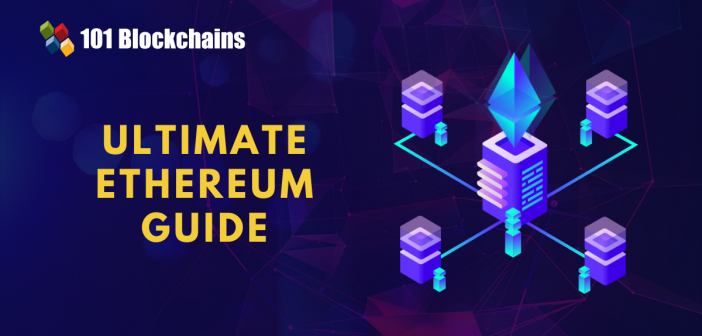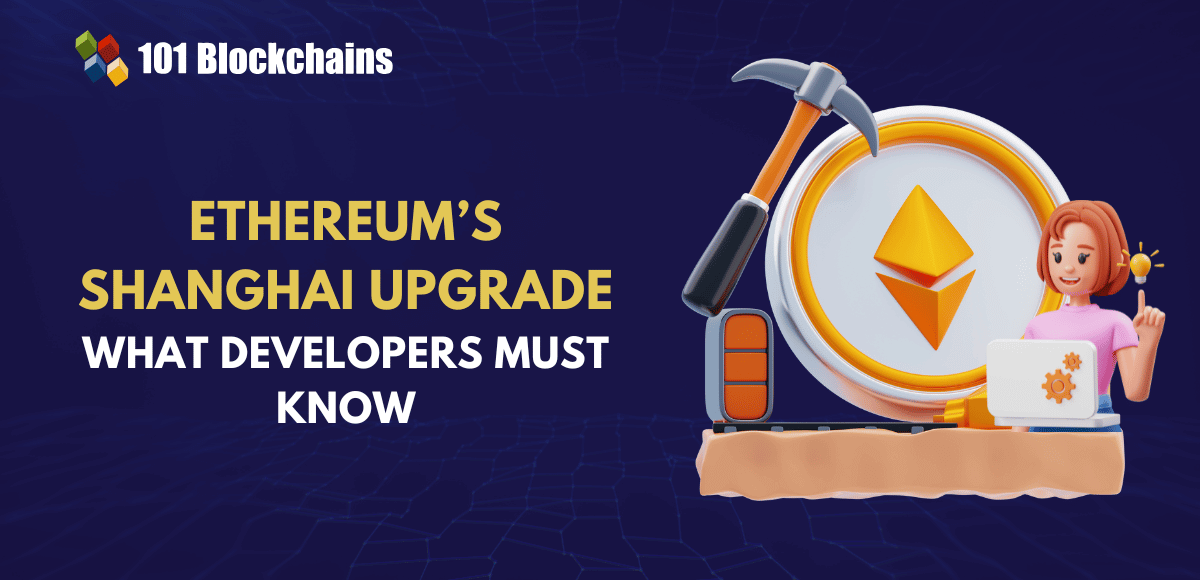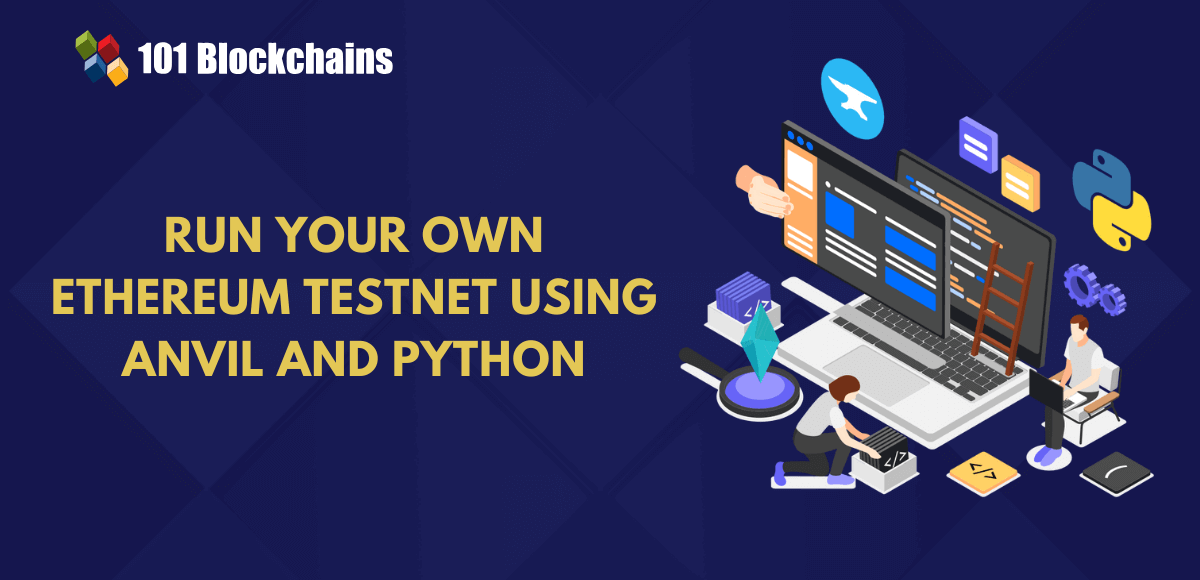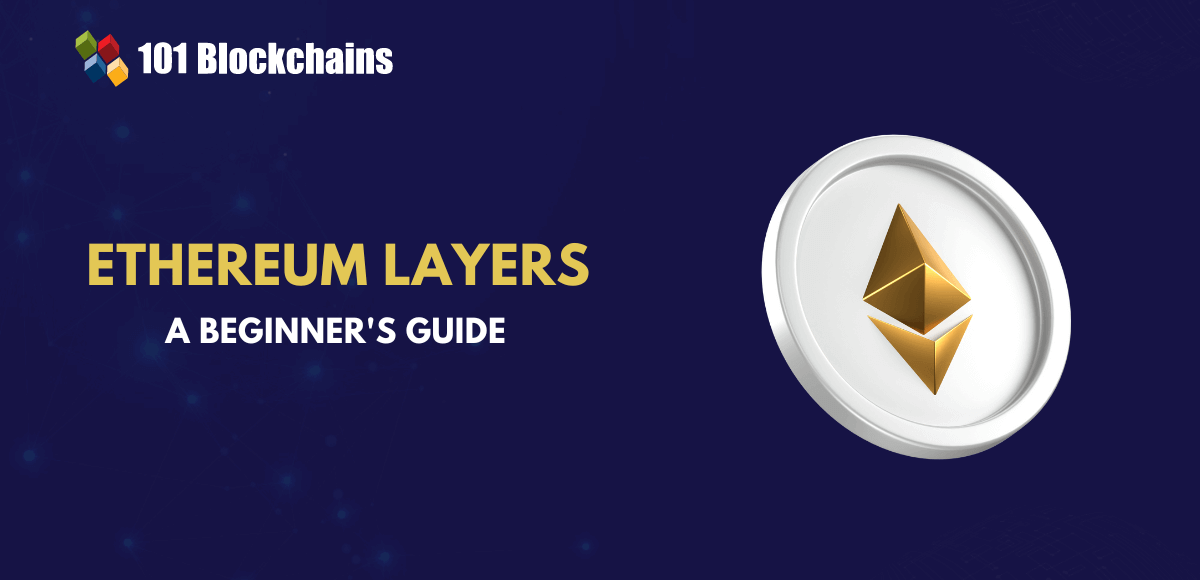Learn how blockchain truly works, master key definitions, and uncover what makes smart contracts so "smart." Dive into the fundamentals, gain valuable insights, and start your blockchain journey today!

- Ethereum
101 Blockchains
- on May 29, 2018
Ultimate Ethereum Guide for Newbies
Ethereum is a disruptive technology platform that is spearheading the efforts of blockchain technology in many ways. This ultimate Ethereum guide discusses the fundamentals of the technology in layman terms for newcomers.
Ethereum redefined the appeal of blockchain technology and showed the world that it can be much more than being just a peer-to-peer cash system. While newcomers mostly associate bitcoins with blockchain technology, cryptocurrencies are only one aspect of the technology.
After all, we surely don’t say that e-mail is the internet — we all know that the overall concept of the internet is broader and vaster.
One of the innovative features of Ethereum is that it is programmable and open-source. So, the users are in the driving seat and develop different applications of their choice.
This programmable blockchain platform specializes in digital assets and innovated a plethora of advanced concepts, such as — decentralized applications, smart contracts, virtual machines, ERC tokens, etc.
So, today’s Ethereum guide will focus on discussing fundamental aspects of Ethereum and its history as it is more suitable for newcomers who are getting familiar with the technology.
Excited to learn the basic and advanced concepts of ethereum technology? Enroll Now in The Complete Ethereum Technology Course
What Is Ethereum? The Ethereum Guide
Ethereum is a decentralized public blockchain platform that is open-source and programmable, allowing users to develop smart contracts and decentralized applications.
In technical terms, one may say that Ethereum is a transaction-based state machine, meaning the system reads an input series and transitions to a new state based on the previous inputs. The transactions are clustered into blocks — thus implementing the core fundamentals of a typical blockchain.
The network users validate the transactions through a consensus algorithm. From the beginning, Ethereum has been using Proof-of-Work (PoW) as the consensus mechanism but it is now aiming to move to another mechanism called Proof-of-Stake (PoS).
Also, Ethereum has an intrinsic digital currency called Ether. The platform also has another currency called Gas which mostly works as a commodity. You will learn about them in detail in the latter part of this Ethereum guide.
Excited to build your skill in Ethereum development by leveraging the ethers.js library? Enroll Now in Ethers.Js Blockchain Developer Course!
What Is A Smart Contract?
Smart contracts are a crucial part of the Ethereum ecosystem as you’ll know in this Ethereum guide. The Ethereum platform is built to allow the creation of Ethereum smart contracts through a peer-to-peer network.
Smart contract is a phrase to describe a computer code that is used by the developers to program their own functionalities. They are known as high-level programming scripts that can be written mostly in Solidity. However, one can use programming languages such as Serpent or LLL.
The fundamentals of smart contract work on a simple principle — two (or more) parties agree upon a set of requirements for a contract, and once all the requirements are met, the contract ends.
Let’s consider the following example for better understanding in the Ethereum guide. X and Y, two parties in a business, agree that if X supplies 10 kg of rice to Y within 10 days, Y will pay $10 to X. They decided to create a smart contract based on the discussed parameters. Now, if X fulfills the deliverables properly, the fund will automatically be cleared and sent to X’s account.
Curious to understand the complete smart contract development lifecycle? Join the Standard & Premium Plans and get free access to the Smart Contracts Development Course Now!
What are ERC Tokens?
One of the biggest beneficial impacts of Ethereum platform is that others developers can use Ethereum’s codebase or token standards to create their own applications. This trait motivates other developers to foster innovation.
ERCs or Ethereum Requests for Comments are the Ethereum platform’s application level standards. Vitalik Buterin, the visionary behind Ethereum first proposed the ERC-20 token standard that allows other applications to re-use the token standard. This is why many ICOs use ERC-20 as the native token.
However, anyone can propose and create ERC standards. Among these, ERC-721, ERC-223, ERC-777, ERC-1155, and ERC-1337 are notable standards.
ERC-721 holds a special place among the standards as it is a non-fungible token NFT. It deals with rare and unique virtual assets.
Aspiring to Become a Certified NFT Expert? Enroll in Certified NFT Professional (CNFTP) Course Now!
What Is Ether? What is the Difference Between Ether and Gas?
Ether is the Ethereum platform’s intrinsic digital currency or cryptocurrency. It is known as a digital bearer asset and does not require a third party to process the payment. However, it does not act only as a cryptocurrency. Instead, it also acts for the decentralized apps within the network.
Gas is another native token of Ethereum. Unlike Ether, Gas theoretically doesn’t have to have any intrinsic monetary value. Rather, Gas works like a commodity that someone spends to use the system.
Think of it like this — we need oil to run our cars. Thus, oil has a monetary value to it. And, based on the demand, oil might have a price tag of $50 per barrel.
In our context, Gas is the oil and Ether is the dollar.
Enroll Now: Ethereum Development Fundamentals Course
How Does Ethereum Works?
Let’s learn about how Ethereum works in this stage of the Ethereum guide. Ethereum is based on Bitcoin’s protocol and its blockchain design. The Ethereum blockchain can be considered as a transaction-based state machine. As the execution of the transaction starts, the machine simply transitions into another state.
Now every state of Ethereum consists of millions of transactions. These transactions are grouped into the form of blocks that are connected together to other blocks. But before the transaction is added to the ledger as it uses distributed ledger technology or DLT, it needs to be validated through a process known as mining.
A lot of miners compete with each other in order to create a block. Once the miner creates a block, Ether tokens are generated and are given to the miner.
EVM- Ethereum Virtual Machine
Before Ethereum was created, the blockchain applications were designed to perform a limited set of operations.
Then came up Ethereum’s innovation-EVM!
Ethereum Virtual Machine is Turing complete software that acts as the runtime environment for smart contracts.
It enables anyone to run the program, irrespective of the memory and time are given by a specific program language. So instead of building a new blockchain network for applications, ETH allows you to develop thousands of different applications on one platform. And since every Ethereum node runs on this virtual machine, applications can simply work as decentralized without having to make their own blockchain.
Moreover, Ethereum Virtual Machine has also been implemented for Java, Go, Python, Ruby, JavaScript, C++, WebAssembly, and Rust.
Ethereum Blockchain Applications- DApps (Decentralized Applications)
In this phase of Ethereum guide, you should learn about decentralized applications. Decentralized applications serve a similar purpose as that of applications, but as they are decentralized — they run on a network of nodes rather than on one central point. DApps are autonomous, secure, easier to implement, open-source, and have 100% uptime.
Read more about dApps here — Beginner’s Guide: What is a Decentralized Application (DApp)?
Most Promising Ethereum dApps
Golem
Golem is an open-source, global, and a decentralized supercomputer that can be accessed by anyone. It makes use of the Ethereum based transaction system that settles the payments between providers, requestors, and developers. Every computation takes place in a sandbox environment and is isolated from the host systems.
OMG Network
OMG Network, previously known as Omisego, is a decentralized application that aims at solving the problems of various financial institutions. This network is a scaling solution for finance on Ethereum and enables the peer to peer and transactions in real-time. With the OMG network, you can simply access and manage your digital assets that are kept on the chain.
Augur
Augur is simply the future of forecasting. It is a decentralized, open-source, and peer-to-peer prediction platform that is built on the Blockchain. Though it seems like a decentralized platform on the surface, Augur comes with a promising potential of predicting the data virtually for any industry.
Civic
Civic aims at giving both individuals and businesses the tools to control and protect their identities. With its decentralized architecture, it provides multi-factor authentication without credentials or any kind of third-party authenticator.
MetaMask
MetaMask is a web browser plugin that allows you to connect to the Ethereum network. You can also use it for peer-to-peer and token swapping.
Ethereum can also be used to build the ‘Decentralized Autonomous Organizations.’ So, what is DAO? DAO is an autonomous and decentralized organization that runs by code written on the Ethereum blockchain.
The people who purchase tokens own DAO’s. But instead of acting as a token, they act as contributions that give people voting rights.
History of Ethereum
To understand the history of Ethereum, we must begin from the very beginning.
2013 – Ethereum White Paper
In 2013, the infrastructure for the new coin was laid. Vitalik Buterin who was then working as a programmer for Bitcoin described the Ethereum concept. Vitalik wrote the first white paper describing it. Later in the same year, he proposed a prototype with a general programming language.
2014 – Ethereum Announcement
In January 2014, during the North American Bitcoin Conference, Mr Vitalik announced the concept. He also named the co-developers of Ethereum i.e., Jeffrey Wilckle and Dr Gavin Wood.
In April the same year, he published Ethereum’s formal specifications in the yellow paper. Vitalik also coded the first fully functional programming language. This was later used as the prototype for Ethereum.
By July 2014, the first sale of Ether was done. The capital that was raised was used to clear legal debts. By August the same year, $14 million had been raised from the Ether sale.
In Sept 2014, the Ethereum ICOs buyers were rewarded with 60 million Ether. The remaining ETH was sent to ether’s non-profit foundation in Switzerland.
In November 2014, a DEVCON-0 meeting was organized in Berlin. This event brought together the developers of Ethereum from all parts of the world. In the meeting, the various aspects of Ethereum technology were discussed. From the event, the various presentations made Ethereum more scalable, secure and reliable.
2015 – Developers Support Ethereum
In April 2015, the DEVgrant program was launched. The program was meant to reward both the developers and supporters of Ethereum. The program helped to fund the Ethereum projects and platform.
In late July 2015, the first Ethereum milestone was released. The Frontier, a smart contract, greatly improved the Ethereum ecosystem.
Also, in the DEVCON-1 meeting the blockchain technology came to the limelight. Ethereum was the forefront of the technology and it was a major boost.
2016 – Ethereum and Ethereum Classic
In March 2016, improvements were done to the Ethereum network. The upgrade was done by Homestead which is an improvement protocol.
In May the same year, Ethereum got a great boost through media coverage. The increased coverage led to the raise 150 million dollars in a general public sale.
In June 2016, Ethereum was hacked for the first time. The hackers claimed to have stolen more than 50 million dollars worth of Ether. This led to numerous disputes in the same month.
In July the same year, due to the disputes witnessed in June, the Ethereum network was split into two divisions. The two divisions were: Ethereum (ETH) & Ethereum Classic (ETC).
Curious about knowing what is Ethereum Classic? Learn more.
Ethereum resorted to decentralized decision-making, extra protocols, and conflict resolution strategies. Ethereum Classic, on the other hand, resorted to code law, blockchain immutability, and the essential rebellion.
The split further led to the disassociation of developers, Ethereum founders, business partners, users and miners from Ethereum classic. These were the prominent differentiating factors of Ethereum vs Ethereum Classic.
2017 – Enterprise Ethereum Alliance
In February 2017, the EEA (Enterprise Ethereum Alliance) was formed. In this alliance, Microsoft in association with established banks and technology geeks advanced for the acceptance of Ethereum blockchain technology.
With the increase in alliances, more and more high-profile organizations and companies were added.
Currently, EEA has over 300+ enterprises as the alliance members. With Enterprise Ethereum, organizations reap the benefit of the Ethereum platform better security and efficiency.
2019 – The Constantinople and Istanbul Forks
In 2019, Ethereum underwent two major hard forks — first the Constantinople fork in February and then the Istanbul fork in December.
Both of the forks optimized the Gas costs for EVMs and added more stability to the system. The Istanbul fork improved the denial-of-service attack resilience and interoperability between Ethereum and Zcash.
It also offered layer-2 scaling solutions based on SNARKs and STARKs.
2020 – Ethereum 2.0 and Beacon Chain Genesis
2020 was a big year for Ethereum as it launched Ethereum 2.0 a.k.a. Serenity with the introduction of Beacon Chain. The Shard Chains upgrade is estimated to launch in 2021. And finally, the Mainnet and Beacon chain will dock or merge in 2022.
The Ethereum 2.0 will run on Proof-of-Stack consensus and say goodbye to energy-intensive mining efforts.
Final Thoughts
Ethereum is by far the most influential blockchain platform in terms of innovation and technological prowess. The real-world problem-solving capabilities and enabling other developers to use the Ethereum tokens for application development are the two pillars of success for Ethereum.
With the successful transition to Ethereum 2.0, the platform will make the current platform more scalable, secure, and sustainable.
So, this was all about the Ethereum guide for newcomers. If you want to have a deeper knowledge about Ethereum, you should take a look at our Ethereum Development Fundamentals Course.





